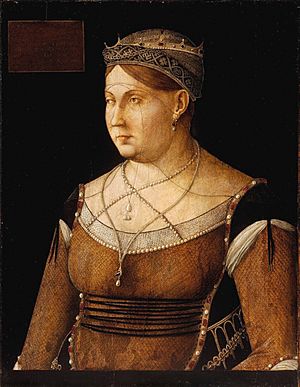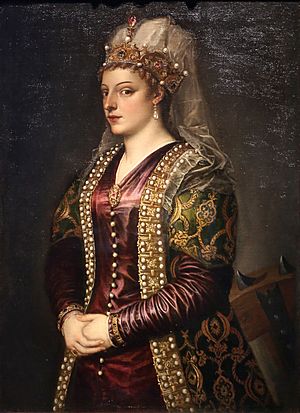Catherine Cornaro facts for kids
Quick facts for kids Catherine Cornaro |
|
|---|---|

Portrait by Gentile Bellini, c. 1500
|
|
| Queen of Cyprus | |
| Reign | 26 August 1474 – 26 February 1489 |
| Predecessor | James III |
| Queen consort of Cyprus | |
| Tenure | November 1472 - 10 July 1473 |
| Born | 25 November 1454 Venice, Republic of Venice |
| Died | 10 July 1510 (aged 55) Venice |
| Spouse | James II of Cyprus |
| Issue | James III of Cyprus |
| House | Cornaro |
| Father | Marco Cornaro |
| Mother | Fiorenza Crispo |
Catherine Cornaro (born 25 November 1454 – died 10 July 1510) was a very important person in the history of Cyprus. She was the last ruler of the Kingdom of Cyprus. She also held the titles of Queen of Jerusalem and Armenia.
Catherine first became Queen of Cyprus by marrying James II of Cyprus. After he died, she became the regent, meaning she ruled for her young son, James III of Cyprus. Later, she became the Queen of Cyprus in her own right. She ruled from 1474 to 1489. The powerful Republic of Venice wanted to control Cyprus. They called Catherine a "Daughter of Saint Mark" to help them take over the island after her husband's death.
Contents
Her Early Life
Catherine was born in Venice, a famous city in Italy. Her father was Marco Cornaro, a knight. Her mother was Fiorenza Crispo. Catherine's family, the Cornaros, was very important in Venice. They had many important people in their family, including four leaders called Doges.
The Cornaro family had strong connections with Cyprus for a long time. They were involved in trade and business there. For example, in the Episkopi area, they ran sugar factories. They sent Cypriot products back to Venice.
Famous artists like Dürer, Titian, Bellini, and Giorgione painted portraits of Catherine.
Becoming Queen
When the King of Cyprus, John II of Cyprus, died in 1458, there was a disagreement about who should rule next. His daughter, Charlotte, and his son, James (who was not born in marriage), both wanted the throne. James tried to take control of the island.
In 1468, Catherine's father and uncle helped arrange a marriage between Catherine and James. This marriage was a big deal for the Republic of Venice. It would help Venice protect its trading rights and other special deals in Cyprus. The marriage plan was agreed upon, and it made James's claim to the throne much stronger.
Marriage to King James II
So, in 1468, James II became the King of Cyprus. He was also known as James the Bastard. Catherine married James in Venice on July 30, 1468. She was only 14 years old at the time. She finally traveled to Cyprus in November 1472 and married James in person in Famagusta.
Ruling for Her Son
King James died soon after their wedding. He became sick very suddenly. In his will, he said that Catherine should rule as regent because she was pregnant. This meant she would rule until their child was old enough.
After the Venetian ships left Cyprus, some people tried to remove Catherine's baby son, James III of Cyprus, from the throne. They wanted Charlotte, the previous king's daughter, to be queen instead. Catherine was held captive for a short time. But the Venetians soon returned and brought order back. Even though Venice had no real right to Cyprus, they started thinking about taking over the island completely.
Queen of Cyprus
Catherine became the official Queen when her son, James III, died in August 1474. He was less than a year old. He probably died from an illness. However, some people whispered that he might have been poisoned by Venice or by Charlotte's supporters.
The Kingdom of Cyprus had been getting weaker for a long time. It had to pay tribute to the Mameluks (a powerful group of soldiers) since 1426. While Catherine ruled Cyprus from 1474 to 1489, the island was mostly controlled by Venetian merchants.
Giving Up Her Crown
In 1488, Venice worried that the Sultan Bayezid II might attack Cyprus. They also found out about a plan to marry Catherine to Alfonso II of Naples. So, Venice decided to call Catherine back to Venice and officially take over Cyprus. In February 1489, the Venetian government convinced Catherine to give up her rights as ruler of Cyprus to the doge of Venice. This meant the Venetian government would now rule the island. Catherine had no other children to inherit the throne.
On March 14, 1489, she was forced to step down as queen. She had to sell the control of the country to the Republic of Venice. A writer named George Boustronios described her leaving Cyprus:
- "On February 15, 1489, the queen left Nicosia to go to Famagusta, to leave [Cyprus]. She rode on horseback wearing a black silk cloak, with all the ladies and knights with her... Her eyes did not stop shedding tears during the whole procession. The people also shed many tears."

Life After Cyprus
Cyprus, which was the last Crusader state, became a colony of Venice. As a way to make up for losing her kingdom, Catherine was allowed to keep the title of queen. She was also made the lady of Asolo, a small region in Italy that belonged to Venice.
Asolo soon became known as a place for writers and artists. This was partly because a famous book about love, Gli Asolani by Pietro Bembo, was set there. Catherine lived in Asolo until 1509. At that time, a war called the League of Cambrai caused the town to be attacked. Catherine then fled to Venice. She lived there for another year and died on July 10, 1510.
Her Lasting Impact
Catherine Cornaro's life inspired several operas. These include Catharina Cornaro (1841) by Franz Lachner, La reine de Chypre (1841) by Fromental Halévy, and Caterina Cornaro (1844) by Gaetano Donizetti.
In Cyprus, the Cornaro Institute was named after her. It was a group that helped promote art and culture. It was founded by artist Stass Paraskos in Larnaca.
Also in Cyprus, in October 2011, the Cyprus Antiquities Department announced plans to fix up Catherine Cornaro's summer palace in Potamia. This project cost one million euros and aimed to turn the palace into a cultural center. Work is still happening there to restore the palace.
Images for kids
See also
 In Spanish: Caterina Cornaro para niños
In Spanish: Caterina Cornaro para niños



